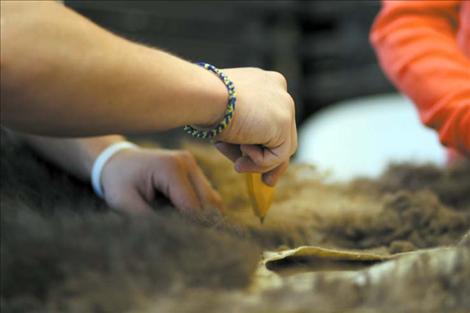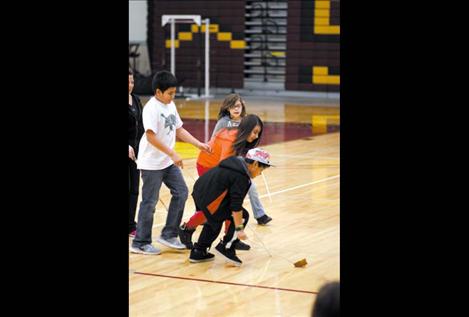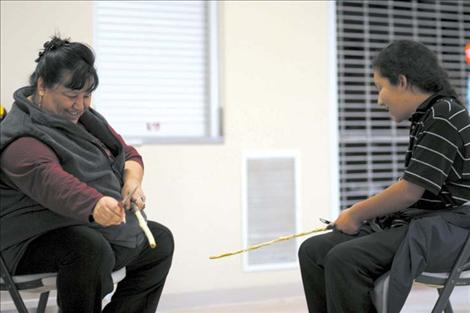Ten Sticks Lacrosse Club promotes leadership, culture
Hey savvy news reader! Thanks for choosing local.
You are now reading
1 of 3 free articles.
PABLO — Alex Alviar, 10 Sticks Lacrosse Club’s founder and former head coach, says he fell in love with the game when he was 12 years old. The love of the game took him all over the country and made him into an All-American. Even so, he said he never understood the depth and berth of the game’s cultural aspect until he attended a workshop with Arleen Adams and the International Traditional Games Society.
“It was a big eye-opener for me,” Alviar said. “I grew up playing lacrosse, but I never knew the extent of the cultural aspect ... there’s this whole other life that the game came from.”
After his experience with ITGS, Alviar said he felt it was important to showcase the culture behind the games and began using native games in the classes he teaches at Salish Kootenai College. He said this is one of the best ways to teach and one of the best ways for students to learn.
It was about this time that SKC’s Learn and Serve program was looking for a way to get local kids involved. Coach Craig Stevenson approached Alviar and asked if they could get the kids from 10 Sticks Lacrosse to do a service learning project.
“I didn’t even know what it would be; I just said yes,” Alviar laughed. “SKC has been incredibly supportive, and so has the ITGS. They’ve been very important allies in doing this.”
Event organizers decided to put together a double-ball clinic Dec. 1 in the Camas room at SKC. Expecting only a handful of participants, Alviar was delighted when nearly 30 kids and their families attended the event.
“I was incredibly surprised at the turnout,” he said. “I honestly felt it would be a small handful of us, and I would have been perfectly OK with that. (The high number of participants) was inspiring to see. I hope that’s a good indicator that interest in lacrosse and native games is growing and that more kids come out — especially younger ones.”
Double-ball is a stick and ball game indigenous to the area. Stevenson said double-ball was a quick and easy game for parents to put together to distract their rambunctious children while working.
A close cousin to lacrosse, Alviar said it is an important cultural bridge between local traditions and customs and the eastern Iroquois game that birthed lacrosse.
“As we got closer to the actual day of having to do it, they came up with the idea of getting everyone together and going into the woods and harvesting sticks for the game with a spiritual and cultural consciousness in order to do it respectfully,” Alviar said.
Several 10 Sticks Lacrosse players helped harvest the materials and lead the younger participants through the process of building double-ball sets.
The double-ball is a strip of buckskin folded over on itself at both ends. These ends are sewn until they are nearly closed and then stuffed with buffalo hair to give them weight. The sticks were freshly-cut branches about 1 inch in diameter and 3 feet long. Stripped almost entirely of their bark, the sticks gave off a welcome springtime smell that rose up to greet volunteers, parents and participants as they laughed, talked and worked the different stations.
The goal was to teach leadership skills, community involvement, the culture and significance behind the game while offering the kids a creative and fun outlet. From the amount of smiling faces and laughter, it certainly seemed like the event met its goal.
Thirteen-year-old Mars Sandoval was one such participant.
“It was fun just throwing it and messing around,” he said.
Not far away, 10 Sticks athlete Beau Mills was diligently dividing his time between shaving sticks and shaving buffalo fur. Mills said he’d come to help Alviar after all he’d had done for 10 Sticks, but said he enjoyed working with the kids.
“One of the best things is teaching little kids how to play and the history of where it came from. I never played double-ball very much, but I love playing lacrosse,” he said.
Alviar said that while the club has athletic goals, the true mission is to build community through native games. For him, lacrosse is a fun and exciting game that can be a point of cultural pride for native and non-native kids alike, shaping their personalities for the better.
“That’s the main thing we wanted to do,” Alviar said. “We wanted to have learning, but we also wanted to introduce the kids to showing them how to lead — even if that just means that you show the younger kids what to do.”
Ten Sticks Lacrosse Club had three all-state athletes last year and another from the year before. They finished the regular season with a playoff berth, and while Alivar was proud of his player’s athleticism and willingness to work hard, he said he was more proud of how the team reacted to being knocked out of the playoffs.
With heads held high and a great deal of respect, the 10 Sticks players showed sportsmanship and composure. Opposing players and their parents noticed and made a point of complimenting Alviar on his team’s level of effort, heart, character and sportsmanship.
“To me, that’s way more important. That’s our primary mission. Do we want to win? Of course,” he said. “But at the end of the day, building better men and women is really what matters.”




















